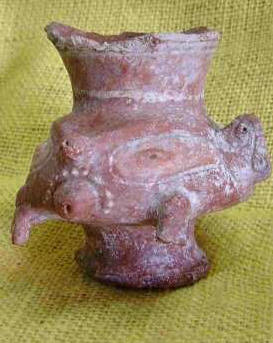 |
||||
|
Ceremonial vessel from Seaview BARBUDA |
PREHISTORY
Prehistory is the story of a country before the advent of the written word describing that land. Columbus discovered Antigua on November 11, 1493, when he sighted an island to the east as he was sailing past Redonda and named the island he saw ŌĆ£Santa Maria la AntiguaŌĆØ meaning St. Mary the Old. History had then begun!
 |
||||
|
Ceremonial vessel from Seaview BARBUDA |
Waladli Religion Art Dance Food Boats Appearance Houses Jolly Beach Indian Creek Royall's Mill Reef Mamora Bay Greencastle Hill Carbon Dates For archaeological research: www.archaeologyantigua.org
AN UPDATE ON OUR PREHISTORY
The prehistory of the Lesser Antilles has considerably changed over the last twenty years due to research made by the International Association for Caribbean Archaeology. Our prehistory may be divided into two periods, the Archaic and the Ceramic. We do not know the names of the first people living in the Eastern Caribbean Islands as there was no written word available in the west so far back in time as 3,000 years before the birth of Christ, the earliest known date of humankind in Antigua or Barbuda so far.
We, in Antigua, have been calling these first people the ŌĆ£SiboneyŌĆØ. This is erroneous, as Archaic people by that name were only living in Cuba according to historic sources. The first people arrived in large oceangoing canoes either from Central America via the Greater Antilles or from South America. Neither direction has yet been proved one way or the other, though the former seems more likely.
The Archaic people may be defined as a people whose economy was based on hunting, fishing and collecting wild resources, and organised themselves into small bands rather than settling in villages. They used the techniques of chipping and grinding to make tools of stone, bone, and shell, and indeed many of these artifacts have been found in Antigua and Barbuda and can be seen at the Museum.
The oldest and most substantial sites of human occupation in Antigua are to be found at Twenty Hill, Parham (c.2900 BC) and at Jolly Beach (c.1775 BC). In Barbuda, ŌĆśRiver,ŌĆÖ near the Martello Tower, has a known date of 1875 BC. The Archaic tribes of Amerindians lived in Antigua and Barbuda up to about 100 BC, and as the next period started some time before this, there was an overlapping of the two periods.
CERAMIC PERIOD
The next period of prehistory is known as the Ceramic Age starting in a minor way about 775 BC. These Amerindians arrived in canoes using the Caribbean Islands as stepping stones as they expanded into the Lesser Antilles. It was in the rivers and estuaries of what is today Venezuela, that the Amerindians had acquired their knowledge of boating and later, around Trinidad, the skills of the sea.
As the name Ceramic Age suggests, the innovation in manufacturing techniques was the firing of the most practical and beautiful pottery, (see also photo above). They brought with them as well some measure of agriculture with the cassava root as their main staple. Being farmers they were more sedentary, thus village settlements were established for the first time.
There are about one hundred and forty-nine prehistoric sites recorded for Antigua and Barbuda. Of these nineteen are in Barbuda. Seventeen sites in Antigua and Barbuda are aceramic, probably of the Archaic Period.
Within the Ceramic Period, different groups of Amerindians are distinguished archaeologically through different styles of pottery. The first group was of Arawakan origin and much later, at about 1500 AD, it is thought, but not proved, that ŌĆśIsland CaribsŌĆÖ worked their way up the islands. Materialistically, from historic records, and through archaeology, no difference can be found between the original and later people, except that styles of pottery change gradually in time. The later pottery is far less sophisticated and a possible religious symbolic artifact, the zemi, is less frequent.
At the end of the
prehistoric period
it seems there were
no homogenous Caribs, for in the
missionary's
dictionary mentioned above, we
note the women spoke Arawakan and the men
'Island Carib', making a homogenous
people, thus agreeing
with archaeology
there is little or
no difference
between them
This brings Antigua and Barbuda's prehistory up to historic times.
To summarise:
| Date range | Characteristics | Language | ||
| Period I | ARCHAIC AGE | c.3,000-250BC |
Hunting, fishing, collecting natural resources. Chipped stone, ground shell and stone tools |
Unknown |
| Period II | CERAMIC AGE | c. 500BC-1500AD |
Agriculture, pottery making, settlements Ceramics, shell and stone. |
Arawakan Cariban |
AMERINDIAN WAY OF LIFE
See also "Arawaks in Antigua and Barbuda"
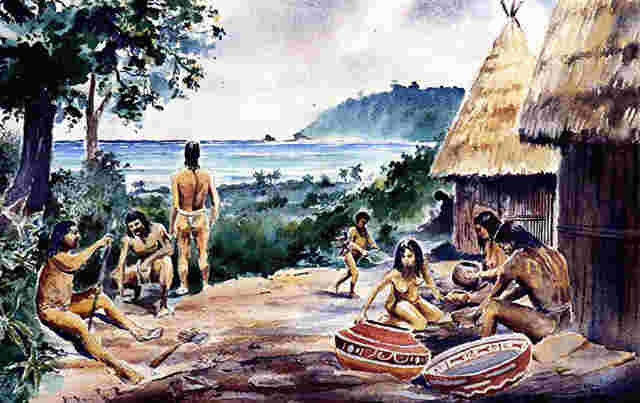 |
If you had been a visitor to our islands not long before Columbus you would have travelled by canoe. The village elder would have sent a host to greet you.
┬Ę On arriving at the large central house (carbet) of the village you would have been provided with a seat and tobacco, or a bed if you were old.
┬Ę To show great friendship, you would have exchanged names with your hosts.
┬Ę If you were special, you would have been given a feast at which all would have made merry with much cassava wine.
┬Ę If unfolded cassava bread was given you , it would have meant you could have taken the leftovers along with you when you left!
┬Ę You would have eaten in silence without drinking. Only one man spoke at a time, whilst listeners hummed if they had approved of his words.
┬Ę Visitors were provided with special hammocks (hamaca) and a woman would have been given to paint your body with a natural paint (roucou) and dress your hair in the morning.
Bon voyage, come again!
Father Breton was a missionary sent out from France to Guadeloupe about 1628 and later to Dominica in an attempt to convert the Island Caribs into Christians. He was unlucky in this task, but we are fortunate, as he wrote a Carib/French dictionary thus enabling future missionaries to carry on his work. This book, available for inspection in the museum, is absolutely invaluable to those that study the prehistory of our islands. It records the lifestyle of the last prehistoric people of the Lesser Antilles.
Here is the book from which we learn that Antigua's Island Amerindian name was OUALADLI and Barbuda's OUA'OMONI (French orthography). Some of Breton's entries are very picturesque, take for instance the Amerindian for little red ants:
Haiuachel - These ants are the smallest but the most troublesome and are found everywhere, in rooms, in chests, in food-safes, in jams, in hay and often enough they penetrate into the most secret places, where they bite so promptly and lively, in whose company you may be, and before you can think, the bite makes you commit an incivility that creates the laughter of those present, but who well know the mystery!
WE LIVE IN WALADLI
When Columbus was near Redonda on November 11, 1593, he sighted the island theAmerindians called ŌĆ£WALADLIŌĆØ and named it ŌĆ£Santa Maria la AntiguaŌĆØ after a miracle working Virgin shrine in a chapel of Seville Cathedral, Spain.
The Amerindian name of ŌĆ£WaladliŌĆØ (since changed by modern Antiguans to ŌĆ£WADADLIŌĆØ by the band in 1979) was found in a French missionary's Amerindian dictionary that can now be inspected at the Museum. Since we speak English the spelling has been changed from the French orthography to English, as can be seen in the accompanying illustration.
The prehistoric name for Barbuda was ŌĆ£WA'OMONIŌĆØ and Redonda ŌĆ£OCANAMANROUŌĆØ.
According to the writings of Ferdinand Columbus, the son of Christopher, the earlier name of Antigua used by the Arawakan speaking people was
YARUMAQUI. This word is believed to be derived from ŌĆ£YarumaŌĆØ, a plant from which canoes and rafts were made and ŌĆ£QuiŌĆØ an island.
The Amerindians,
that we know as the
Arawaks and Caribs,
at the time of
European contact
were of good
stature, well
proportioned, strong
and robust. Their
natural colour was a
very bronzed olive.
The Ameri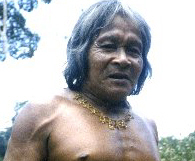 ndians
never wore clothes;
they sometimes wore
a belt that hung in
front with windings
attached to the
men's private parts.
The women wore a
cotton band four
fingers wide.
Sometimes the
unmarried women wore
a skirt or apron.
ndians
never wore clothes;
they sometimes wore
a belt that hung in
front with windings
attached to the
men's private parts.
The women wore a
cotton band four
fingers wide.
Sometimes the
unmarried women wore
a skirt or apron.
HAIR - The hair was worn long with a fringe near the eyebrows. A parting was made across the head from temple to temple, leaving two small moustaches over the temples. Before the Amerindians travelled, the women combed the men's hair and greased it with oil to make it shine and look blacker. Coloured feathers were sometimes stuck into the bundled hair. At the back, their long black hair fell freely in graceful negligence. Slaves were not allowed to wear long hair.
FACE
- Often the forehead
was flattened for
good looks. Carib
babies had their
head flattened with
boards or cushions
or by the mother
placing her hand and
elbow on the head
and sleeping on
them. Ear-disks made
from modified fish
vertebrae were worn
in the lobes of the
ears.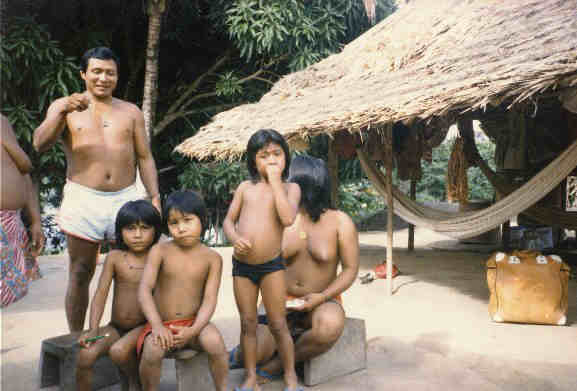
ADORNMENT - Necklaces were made of seashells and with transparent fish bones. Often wings of various birds were worn around the neck, which they let dangle over their shoulders and over their bellies. Other times a whistle made from the bones of their enemies hung around the neck.
At the feet little bells of seashell were worn to ring while dancing and the women wore a little sash with bells attached. The rattle of snail shells accompanied dances on strings that dancers wore around their arms, hips, calves and heels.
BODY PAINTING - Every day Amerindians reddened their bodies with a mixture of roucou and castor oil. It was believed this would please their enemies and that they would have nothing to fear if they took this precaution. After painting their husband's body with roucou the wife wiped her hands on her leggings to stiffen them. For fine black paint to be used for facial painting, gum was burnt from the root of the gum tree. Men often stood for twelve hours while his wife drew curves and lines from shoulders to buttocks. She also covered the back, arms and chest with fanciful lines, which were not unpleasant to look at. This decoration was made for warfare and for feasts.

The first people that came to Antigua built no houses, for the Archaic people roamed from place to place looking for their life sustaining natural resources.
Later when the Arawakan-speaking people arrived at about the time of Christ, they brought horticulture to Antigua and Barbuda for the first time. To tend their cassava crops it became necessary to settle. That was when houses and villages were first built in Antigua.
According to the first missionaries and to the results of archaeological excavations, Arawakan houses were round and measured about 12 feet across. Roofs were supported by a strong central post about 25ft high. This great height was necessary to make their roofs of thatch waterproof, for rainwater was able to run off fast with so steep a roof.
Balanced atop the house within the extensions of the roof poles was a large rock. This was supposed to bring luck to the inhabitants of the house. The Amerindians invented the hammock, which name is derived from the Arawakan word, "hamaca". Hammocks were slung from the central post to the round surrounding wall.
The basic Amerindian belief was animistic, which means that all objects and even the universe itself possessed personalities, souls or spirits. Some objects harboured GOOD spirits, while others possessed EVIL spirits. The world crowded with spirits was terrifying to the Amerindians. Their life was spent trying to gain the goodwill of these spirits.
There were three main Gods of the Arawakan-speaking peoples. Yocahu was the supreme god, the God of Cassava. Atabeyra the Goddess of Fertility and Childbirth and Opiyel Wa'obiran was the Guardian of the spirits of the dead.
This latter God usually took the form of a dog. A beautifully carved dog's head made from a Fighting Conch shell was found at Freetown in the 1960's.
Benevolent spirits were believed to have resided in Zemies. These were images made of stone, shell, coral, cotton or ceramics. Zemies controlled and influenced daily activities. They favoured crop growing, hunting and fishing.
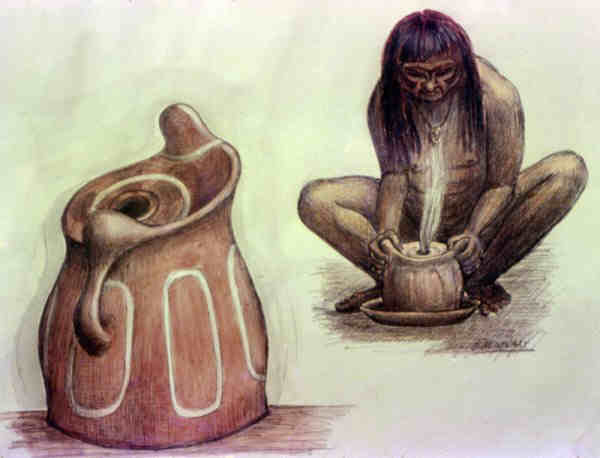
Shamans or Medicine men worked with the supernatural as both priest and doctor. These men were able to influence powerful spirits. Tobacco was used as a narcotic with which they intimately conversed with the Gods. A leaf was dried by fire and crumpled into a powder. This was mixed with white ash and seawater, dampened and placed between lip and gum. At the Museum there are examples of pottery 'incense burners' found in the various village sites of Antigua & Barbuda in which Cahoba, a narcotic plant of the Mimosa family was burned.
Drawings were carved into rock at special places, as at bathing places or cave shelters. They were intended to guard against evil spirits. A petroglyph is the present day term for a rock drawing. The only known petroglyph of Antigua and Barbuda is to be found in a cave in Barbuda.
At the Museum, a folder showing various designs found on pottery may be obtained. These designs can be used in modern day handcrafts. It is so much better to use our own native motifs rather than designs from Hoboken, Honolulu or Haifa!
Look at these - They are part of the brochure obtainable at the Museum:

Dances took place during feasts and drinking sprees. The musical instruments used were flutes and drums.
Many of the Amerindian dances imitated animals and birds. One of the South American Arawak dances was the "Humming Bird". It probably took the form of a darting to and fro. Dances differed in each tribe or family. In some, the body was moved in a slow and stately manner, with the head held in a grotesque position. Men stood in a long line with their arms linked and the women opposite, likewise. The lines then advanced and retreated, all the time singing a monotonous chant, with each individual stamping hard upon the ground. Occasionally they break up to drink and then resume the same dance.
Sometimes a man and a women would get together and link arms and strut about slowly together, bending their bodies forward and backward, this side and that, very grotesquely. Dances always ended with a loud and discordant uproar, which was a signal for renewed drinking.
One particular tribe danced with each dancer representing a different animal. Each held a stick with an image of their animal on the end. One dancer would imitate a wild animal and pounce on another dancer to take him out of the ring. In the end, he would be alone to finish the dance.
A dance of the Warrau tribe was described by the early missionaries as follows: When the cassava was ripe, the men went to catch crabs and the women made a special kind of cassava cake. When the men returned there was a feast. A young man and woman was placed in a circle separated by an arrow pushed in the ground with a doll stuck on it. The man locked his fingers together on his stomach and the woman likewise, on her apron. The dance consisted of a few single steps on the spot, different for man and woman. Both then stared at each other in the face, without any movement whatsoever of the mouth and eyes. The slightest sign of laughter disqualified either one. The offender was bundled out of the ring and the crowd shouted, "That man/woman is no good. He/she will never get a wife/husband!".
Mainly fishermen, the Amerindians we know as the Caribs and Arawaks, geared their lives to the bounty of the land and sea.

FOOD GATHERING METHODS - Digging sticks were used for planting gardens and fire was used for forest clearance. Line fishing was carried out with shell and turtle shell hooks. The thread was made from pineapple, dagger tree and other fibres.
Fish were shot with the bow and arrow from the rocks and then retrieved by diving. They were often inebriated first using a certain beaten up bark of a tree( Piscidia sp.) Nets were made of palm fibre or cotton. Rocks were taken to dive for lobsters and for conchs.
Turtles were caught by slipping a cord around their flippers and by harpooning.
Crabs were searched for at night by using torches made from Torchwood. Pelicans and kingfishers were tamed to fish for them. Hunted were:
Rice-rat, birds, iguana, snakes, worms, insects, spiders. Birds were shot with an arrow with a wad of cotton on the end instead of a sharp head. Birds were trapped in small traps and also by a strong glue from resins. Parrots were gassed from fires lit under trees in which gum, green pimentos or peppers were burnt.
COOKING METHODS - Food was often roasted on a boucan, from which we get the word 'barbecue'. Food was also roasted in the embers of a fire. The ash formed a jacket that was later scraped off. Sometimes roasts were wrapped in clay and placed straight in the fire. When the clay was broken open, feathers or scales came with it.
Boiling was not so common except for crabs. Crabs were cooked in a pot with little water and much red pepper, the whole being covered with leaves. Fish, half gutted and with scales left on, were also cooked this way. No salt was ever used.
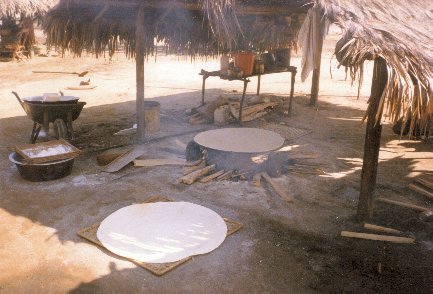
CASSAVA - This root vegetable (Manihot esculentas) was the main staple of the Amerindians. The Cassava plant grows easily, but is a factor of soil degradation. This is probably the reason why the Amerindians moved slowly up the Lesser Antillean chain when they left South America at about the time of Christ. Cassava kept and travelled well in ocean-going canoes. After processing, it produced flour, bread loaf (6 ins thick) and several other varieties, a sauce called cassareep and a wine. As a vegetable it was light on the stomach. It was cooked over a fire on a griddle.
PROTEIN - Agouti (Dasyprocta aguti) was a dark brown rodent that lived in Antigua about the size of a rabbit, and was introduced from South America. Agouti were hunted by non-barking dogs. It was kept for a day as it was too gamy, then it was salted, smoked and boiled in cassava juice for a long time to tenderise it. The guinea pig (Cavia porcellus) was another mammal occasionally used as food.
Larger birds, like Terns, had their wings cut half off and were turned in the fire to burn off the feathers. They were then left on a grill to smoke. Small birds were wrapped in leaves to cook slowly. The outer skin was peeled off and the guts taken out. They were eaten without a sauce. Sometimes small birds were boiled in cassava juice with peppers, they had been smoke-cured, then drawn and feathered. Flamingos and parrots were aboriginally present in Antigua and were prized for their flesh and colourful feathers.
Fish was boiled in fresh water, often half cleaned without being scaled. It was sometimes roasted on a spit. Fish was seasoned with peppers. Sea food was kept alive in corrals until needed, this was a common food storage method.
Crabs were a delicacy. Many different species of crabs and shellfish have been found archaeologically in kitchen middens (garbage dumps). Conch and whelks appear to be the commonest in most village sites.
THE PEPPER POT was called Tomali (Toma= Sauce, ali= clay pot). This method of cooking was a ingenious type of food storage. A rich brown pungent sauce was made by boiling any or all of the following available items:- fish heads, bones of fish, agouti, rice rat (Oryzomys spp.), iguana, birds, monkey, seashells (chip-chips, oysters, whelks) into a deep clay fire pot with peppers, sweet potatoes, cassava juice and fine cassava flour. Cassava bread and other meats were dipped into this stew. It was boiled continuously and added to next day. Father Breton noted that it was rather unhygienic (even by 17th century standards!) as often roucou (body paint) and old women's hair was always found in pepper pots.
VEGETABLES and FRUITS - Maize (corn) was roasted on coal and maize cakes, Kayzu, were made by boiling. Green maize soup was also made. Other vegetables were:- Yams Kuchu, beans Mankonti arrowroot baked, Carib Cabbage Taya was used as a seasoning. Peanuts were eaten with cassava. Some fruits were the pineapple, introduced from South America and the native coco plum (Chrysobalanus icaca L.) Native seaside grapes and the fruits of the prickly pear cactus were also eaten as well as many other introduced plants as avocado, soursop, guava, paw-paw and mamey.
DELICACIES - Delicacies were raw fish eyes and the entrails of the sea-cucumber were sucked out. If food was short, these holothurians were rubbed in the ashes of a fire to rid them of their slime and then cooked. Another delicacy was lice, particularly those from the heads of their enemies, these were rolled between the teeth for a quarter of an hour to savour. Toads (houa), snakes, worms and insects were also eaten. The Amerindian thus exploited natural resources to the maximum. They were very fond of honey.
BEVERAGES - The main alcoholic drink was cassava wine, Wi'ku. This was a heady drink made from cassava and sweet potatoes fermented in syrup and water. "Gossiping old women" chewed and spat out the cassava which was fermented in pots. A beer was made from maize Pallino, and pressed pineapples were used. The juice was probably left to ferment as a wine. A soft drink was honey and water Maba, and another was made from the cooked roots of the Carib Cabbage. An unknown plant called Karratas was used to make a drink to quench the thirst when far from water. During the European contact period, the Caribs pounded sugar cane in a pestle and boiled it to make a drink.
RECIPES - Tacallalaca - Throw into a pot the bones of a fish just eaten, add handfuls of red pepper, cassava water and very fine cassava flour and a few pieces of crab; stirring the whole with a flat-ended stick.
Hot sauce - Make from boiled cassareep juice and squashed pimento. Limejuice was included after European contact.
Plants played an essential part in the daily social and economic life of the early islanders.
A plant-based culture provided the early people with food, utensils, ornaments and drugs in fact materials of all kinds. To say the least, Antigua & Barbuda's environment was fully exploited.
The early islanders brought with them from South America their principal useful plants, without which they would have had to rely on the scarce resources of the natural flora and fauna of the Lesser Antillean Islands.
AMERINDIAN BOATS
Early boats of Antigua were hollowed out tree trunks and may have been given extra freeboard by adding planks on either side. Arawakan speaking Amerindians that appeared from South America made these boats. Firstly, a large tree was chosen and fire was set around the base to kill it. Then it was left standing for a year or so to season. A favourite boat-building village was probably on the hill east of MonkŌĆÖs Hill where the cell phone antenna is today. We know this because many conch-shell hand adzes, flint tools and pottery have been found at that spot. According to the missionaries, these adzes were used in conjunction with fire to hollow out the tree trunks. The trees were chosen from the interior of Antigua behind the hill, cut down and hollowed on the spot. Then a team of men dragged the bare hull to the village for finishing. It would have been an easy matter to take the canoes to Falmouth Harbour, as the canoes were literally slipped down the side of the steep hill to the water for launching. Canoes were the automobiles of the early people. They were used for communications around the coasts, fishing and even inter-island trade, proof of which has been determined archaeologically.
THE ORIGIN OF SAIL - It is thought sail was not used until after 1605. In this year, three Spanish Galleys were wrecked on Guadeloupe and the Caribs murdered all the crews. One friar, a certain Father Blasius from the Low Countries, was spared as he had shown the Indians how to make sails out of the linen cloth that had been a part of the shipsŌĆÖ cargo. He showed them how to make a fore and aft spritsail (common in the Low Countries), the innovation pleased the Caribs as the sails had saved them much labour. Incidentally, Father Blasius made his escape by using one of his sails one night when he saw a British merchantman the ŌĆ£Henry ChallonsŌĆØ approaching the lee of Guadeloupe. From that time on, sail was reported in the Caribbean in historical records, and until recently, the Carib Canoes of the Eastern Caribbean used the same sprit rig, utilising flour sacks sewed together as sail cloth.
CARIB SEA LORE from a Carib/French Dictionary published in 1660 by Father Breton.
During canoe building, if a woman had touched the boat with but the end of her finger, the Caribs believed the canoe would split and be leaky.
The word for the Master of the Canoe and for the calabash bailer is almost the same as the skipper bailed throughout the voyage.
The word ŌĆ£to voyageŌĆØ literally means ŌĆ£to loot on waterŌĆØ or to raid.
The tiller was always left unworked or unfashioned , otherwise it would not guide the boat well at sea.
The crew sometimes wore a woven hat of cachibou leaves called a bakoua to protect from the sun and the sea.
The Caribs had a word which meant, ŌĆ£I wish the wind and waves would take us and push us from the stern!ŌĆØ
When they saw a dirty looking squall approaching, they would blow into their hands saying Piom, which means ŌĆ£Go far away!ŌĆØ
At the end of a voyage, the canoe was pulled up on rollers and the word is the same as horse, cart, and wheels. It even alluded to women as they make men ŌĆ£go alongŌĆØ.
Archaic Period

The Amerindian Jolly Beach site belongs to the earliest age of human settlement in Antigua and Barbuda and is the best-known complete habitation site of the archaic age. Two radiocarbon dates of 1,775 and 1,589 BC show the site was occupied about 3,500 to 4,000 years ago. By the archaic age we mean the people's technology had not reached the stage of pottery making or even the practice of agriculture. The Jolly Beach people had lived simply off marine resources and various native plants. Their tools were made of volcanic stone, flint, shell and wood. Tools excavated archaeologically include hand tools or chisels formed by the grinding of thick conch shell lips, ground stone axes or celts for making canoes, pestles for preparing food, flint blades for cutting and scraping, and simple beads and pendants.
The Jolly Beach site is situated between two small hills east of the hotel gate. On the eastern part of the site a large house has already been built. Unfortunately there is no legislation to preserve our historic sites so that future Antiguan archaeologists may study them.
When the site
was originally
occupied some
3,500 years ago,
it would have
been a
peninsula, as
sea levels were
about 10 ft.
higher than
today. The
rocky area on
which the
supermarket is
situated was at
the end of the
peninsula.
Indeed at the
end, there is a
cave water worn
by the sea in
former times.
The Jolly Beach people may have originally come from South America, as similar tools have been found there. They have also been collected at Ortoire in Trinidad; hence archaeologists call the Jolly Beach site. We have no idea of the name of the tribe that lived there or the name of the language they spoke, unlike the later Tainos and Island Caribs who were observed by the European missionaries and explorers.
Ceramic Period
The Indian Creek village site can be found about half a mile up the Indian Creek inlet on the south-east of Antigua. The Amerindian village site is an internationally known prehistoric archaeological site and is the most important on Antigua. Just before the time of Christ, maritime Arawakan speaking people arrived by canoe from South America. These agricultural people cleared the valley to grow their main staple ,cassava. Their life was sustained by the many different types of natural resources to be found from the mangroves, the creek and the sea. Arawak art was of high aesthetic quality and their agronomy was most productive in the CaribbeanŌĆÖs ancient world. The settlement, whose population was about 50, lasted until about 1200 AD.


ADORNO FROM THE RIM OF A VESSEL MODELED FROG ON VESSEL WALL
In 1973, Yale University made several excavations, where workers unearthed middens (garbage dumps) on this site where Arawak chiefs and shamans had apparently lived, bringing to light long buried religious artifacts so that the Historical Society could continue reconstructing the religious practices begun by earlier work. Only about 1% of the site was excavated; the idea being that the rest should be left for future Antiguan archaeologists and for when better and more advanced method will be developed.
We believe this site would make an interesting eco-tourism attraction. Amerindian houses are simple to build. Three full sized ones would make the site come alive. One house would be a museum showing the many artifacts that have been found there, another for facilities and the other for a caretaker and guide/lecturer. The interiors of the latter two would be modern.
INTERNATIONAL REFERENCES
JONES, ALICK 1978 Dietary Changes of the Arawaks at Indian Creek, Antigua. Am. Antiquity,Vol.50:3 913.031'155'Z5
OLSEN, FRED 1974 Indian Creek: Arawak Site on Antigua, West Indies. Norman: Univ. of Oklahoma Press. 972.974'004'
OLSEN, FRED 1974 On the Trail of the Arawaks Univ. of Oklahoma Press, 408pp. 970.3
ROUSE, I.& FABER MORSE BIRGIT 1999 Excavations at the Indian Creek Site, Antigua, West Indies Yale University Pubs in Anthro.No.82 1999,70 pp. 972.974'004'
STEADMAN 1980 Faunal Remains from Indian Creek. .See also Z2 Unpublished 913.031'155' Z2
GOVERNMENT MAP, PLAN n.d. Plan of Piccadilly Lands at Indian Creek, with owners. Unpublished 972. 974 I2
Information from the Museum of Antigua & Barbuda
This is an early ceramic period village site (Saladoid), about the same period as Indian Creek. The earliest carbon date attained so far for the site is 300 AD. It site is situated on the north coast of Antigua and discovered in 1998 by John E. Fuller, when being developed for modern housing. Many beautiful pottery sherds have been found as well as a large quantity of beads, both finished and unfinished, manufactured from semi-precious stone.
There was some archaeological research carried out by Dr. Reg Murphy and the Calgary Archaeological Summer in 1998.
POTTERY excavated by the Antigua Calgary Summer Archaeological School.
Top & bottom rows: Reconstructed ceramic bowls.
Middle row: Rim adornos
From about 400 A.D. agricultural Amerindians from South America built a permanent village within the todayŌĆÖs Mill Reef Club property. They lived here for about 600 years, depending on sustenance from natural resources readily available from the coral reefs and small islands of the area, as well as the fertile valleys behind the shoreline. The village was placed near a small hypothetical stream and in a sheltered position behind a low ridge parallel to the sea.The stream gave rise to the name of the site as the ŌĆ£BrookŌĆØ.
First Archaeology - Dr. Fred Olsen, Dr. Irving Rouse of Yale and Robertson ŌĆśHappyŌĆÖ Ward, assisted by Mill Reef Club members, commenced the first scientific archaeological excavations in Antigua in December 1958. It is estimated that over one hundred thousand sherds were collected. Subsequently the best artifacts were displayed in the old mill tower museum at the Mill Reef gate. Most of the artifacts are now housed at the Museum of Antigua and Barbuda.
Perhaps the most interesting find, uncovered through careful excavation, was a pair of large green stone celts or axes found in association with ash. A charred house posthole was also located, so it was assumed the hafted celts were consumed in a burned down house. Radiocarbon dates from the ash gave a reading of about 550 A.D. Today, archaeologists refer to Mill Reef as a ŌĆ£type siteŌĆØ. Its style of pottery is indicative of the middle period of Antiguan prehistory, 500 - 900 A.D. For decoration, white painted bands on a red background were applied by brush. This form of painting followed the earlier Indian Creek style, in which the pottery was painted overall with a white colour and then rubbed off to form the design.
MAMORA BAY
At Mamora Bay there is an Amerindian village site important to the archaeology of Antigua. It is a type site, that is to say the broadline incised decoration of its pottery is an attribute to a particular style. This was first found at Mamora Bay by Dr. Fred Olsen about 1960, so it is known as the Mamora Bay Style or Complex. Having been dated (c. 900 - 1200 AD), we can thus date other Antiguan sites that possess that style of ceramics. Other sites that exhibit the style are at Emerald Cove, Indian Creek, Blackman's, Coconut Hall, Jumby Bay and Hawksbill.
The site was explored by Dr. Charles Hoffman of the University of Florida in 1962, who first described the ceramic style. When the Mamora Bay Hotel was built on the peninsula in 1963, several burials were found, the bodies having been put to rest in a squatting position.
Several hotels have since been built on the site; development has taken place without any scientific archaeological excavation. Much of our prehistoric heritage has been developed over by hotels. Locations that were prized by the Indians are also prized by today's developers! Unfortunately there is no Development Control in this regard.
A note on the characteristics of the Mamora Bay style:
Rather thick walled hemispherical shaped vessels often decorated with a special design made with a curvilinear broadline incision. There are no handles or modelled incised and tabular lugs. The scratching of surfaces continues, as well as the appearance of three-pointed stones or zemis. Absent is white-on-red painting, also handles disappear. "Troumassoid" influences include: Wedge shaped lugs on a triangular rim and red painted ridges within rims. (Rouse).
GREENCASTLE HILL
HISTORY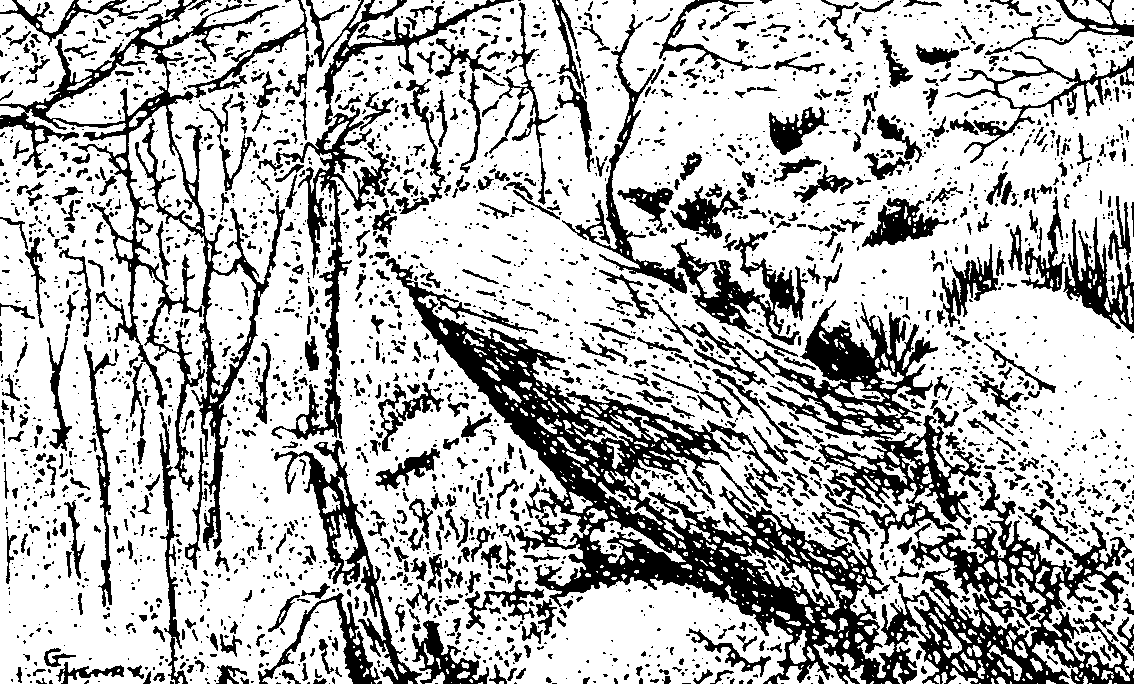
This
565 ft. hill was
once an isolated
volcano, which was
later exposed to
wave action, so that
an array of
close-fitting
rhomboidal and
polygonal columns
was formed. These
stone features
include the
"megaliths" and
"sacrificial slabs"
which are considered
by some authorities
as the remains of a
prehistoric
astronomical
observatory and
temple. It was here
that scenes of
religious ceremonies
and phallic worship
were perhaps
centered. Indeed
pottery sherds of
the Arawakan
speaking Indians
have been unearthed
on the western side.
It is here that
scenes of religious
ceremonies and
phallic worship were
perhaps centered. If
this were so, what a
wonderful addition
to our tourism
product this
historical resource
could make!
A more contemporary
feature is the grave
of the Earl Baldwin
of Bewdley, Governor
of the Leeward
Islands, 1948 -
1950, and son of
Oliver Baldwin, a
one time Prime
Minister of Great
Britain. An open-air
study of nature and
a beautiful view of
fair Antigua would
also be obtained if
this historic
heritage site was
made a special
tourist attraction.
An interesting and
informative nature
trail should be
designed covering
the better-known
megaliths. These
include remains of
stone circles,
altars, and, with
the megaliths, which
all suggest the hill
was once an
astronomical outlay
for the measurement
of time. Some of the
megaliths have been
called the Chair
Rock, Phallic Rock,
West Turning Rock
and the Tomb.
Greencastle Hill is
a very important
heritage site and
well known
internationally. The
most provocative
publication is a
report by a
researcher from
Trinidad, Dr. Maura Imbert some of which
was published in ŌĆ£
At this point in time, it is safe to state that the existence of a "Tropical Stonehenge" or perhaps a temple dedicated to the Pleiades) on Greencastle Hill during the period 500-1250 A.D. is well within the bounds of possibility!
For further reading in a more technical vein see:
Is There a Tropical Stonehenge on Greencastle Hill? by Dr. Imbert, in the Historical and Archaeological Society Newsletter No. 75, Oct. 2001, page 5. Obtainable from the Museum of Antigua & Barbuda.